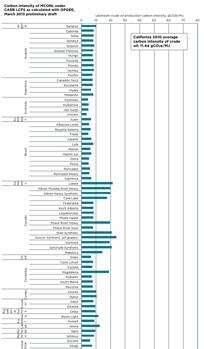Blog
The changing oil landscape, and the need for regulation
In January, ICCT collaborated with the Carnegie Endowment for International Peace and the Energy Foundation to present a symposium in Washington DC looking at the new realities of a world rich in unconventional oil. Following on from that event, I have been working with Deborah Gordon from Carnegie on a short report, “Uncovering Oil’s Unknowns”, exploring the changing face of the upstream oil sector and the new realities of a world in which peak oil may have been indefinitely delayed, and where unconventional (and often higher carbon intensity) oil resources will form a growing part of the supply mix. While conventional oil resources are indeed being depleted, oil companies have shown that they still have the capacity to replenish reserves through frackable shale oil plays, extra heavy oils and bitumen like the Athabasca tar sands, deep water and Arctic fields, and perhaps through very low grade resources such as kerogenous oil shales.
It is not only the ICCT and Carnegie that have been shining a spotlight on unconventional oil recently. The Carbon Tracker Initiative in the UK has demonstrated that even existing levels of energy company fossil fuel reserves seem incompatible with controlling climate change (if they were all combusted). Carbon Tracker talks about the Earth’s ‘carbon budget’ to 2050 – the amount of carbon dioxide that can be released without causing more than 2 degrees Celsius of climate change (an analogous but larger budget could be assigned to keeping below 4 degree warming and so forth). Within that carbon budget, we can produce a certain amount of energy from fossil fuel – but the more of that energy that is produced from carbon intensive fuels such as coal, bitumen and high carbon intensity oils, the less energy bang humanity will get for its carbon buck. The work with Carnegie, as well as an ICCT study earlier this year that analyzed the carbon consequences for the refining sector of a heavier crude slate,demonstrate the risk of moving to higher carbon petroleum fuels in years ahead.
 In the coming decades, regulatory action will be needed to manage the various environmental implications of the shift to new oils, especially if climate change mitigation targets are to be hit. First, of course, vehicle policies that limit the demand for all petroleum fuels (e.g. see the ICCT Roadmap) reduce the need to increasingly extract more fuel from harder-to-reach places. Second, fuels-based policies will be increasingly important in shifting fuels investments. In California and Europe, the Low Carbon Fuel Standard and Fuel Quality Directive, respectively, are setting the pace by regulating the carbon intensity of oils, and by providing incentives to reduce the carbon intensity of oil production. In California last Thursday (20 June 2013) the Air Resources Board held a workshop to discuss expanding its program to provide credits for innovative upstream oil extraction emissions reduction projects; CARB has already analyzed 275 different ‘Marketable Crude Oil Names’ to assess the carbon intensity of the California fuel pool (see image to right). This shows that the analytical tools now exist, and in the case of OPGEE are open source and available in the public domain, to start dealing with the carbon emissions embedded in oil production. In Europe, the European Commission is in the process of completing an impact assessment of options to account for fossil fuel carbon intensity under the Fuel Quality Directive – the initial proposal is to discriminate between the carbon intensities of different oil feedstocks. That proposal also includes measures to credit upstream emissions reduction projects, such as initiatives to reduce associated gas flaring and venting. In North Dakota, regulatory incentives are being offered to producers that avoid gas flaring in the Bakken shale. The World Bank estimates that associated gas flaring is responsible for 400 million tonnes of CO2e emissions every year – effective incentives and regulation to improve upstream efficiency can, and in due course will, deliver major emissions reductions.
In the coming decades, regulatory action will be needed to manage the various environmental implications of the shift to new oils, especially if climate change mitigation targets are to be hit. First, of course, vehicle policies that limit the demand for all petroleum fuels (e.g. see the ICCT Roadmap) reduce the need to increasingly extract more fuel from harder-to-reach places. Second, fuels-based policies will be increasingly important in shifting fuels investments. In California and Europe, the Low Carbon Fuel Standard and Fuel Quality Directive, respectively, are setting the pace by regulating the carbon intensity of oils, and by providing incentives to reduce the carbon intensity of oil production. In California last Thursday (20 June 2013) the Air Resources Board held a workshop to discuss expanding its program to provide credits for innovative upstream oil extraction emissions reduction projects; CARB has already analyzed 275 different ‘Marketable Crude Oil Names’ to assess the carbon intensity of the California fuel pool (see image to right). This shows that the analytical tools now exist, and in the case of OPGEE are open source and available in the public domain, to start dealing with the carbon emissions embedded in oil production. In Europe, the European Commission is in the process of completing an impact assessment of options to account for fossil fuel carbon intensity under the Fuel Quality Directive – the initial proposal is to discriminate between the carbon intensities of different oil feedstocks. That proposal also includes measures to credit upstream emissions reduction projects, such as initiatives to reduce associated gas flaring and venting. In North Dakota, regulatory incentives are being offered to producers that avoid gas flaring in the Bakken shale. The World Bank estimates that associated gas flaring is responsible for 400 million tonnes of CO2e emissions every year – effective incentives and regulation to improve upstream efficiency can, and in due course will, deliver major emissions reductions.
